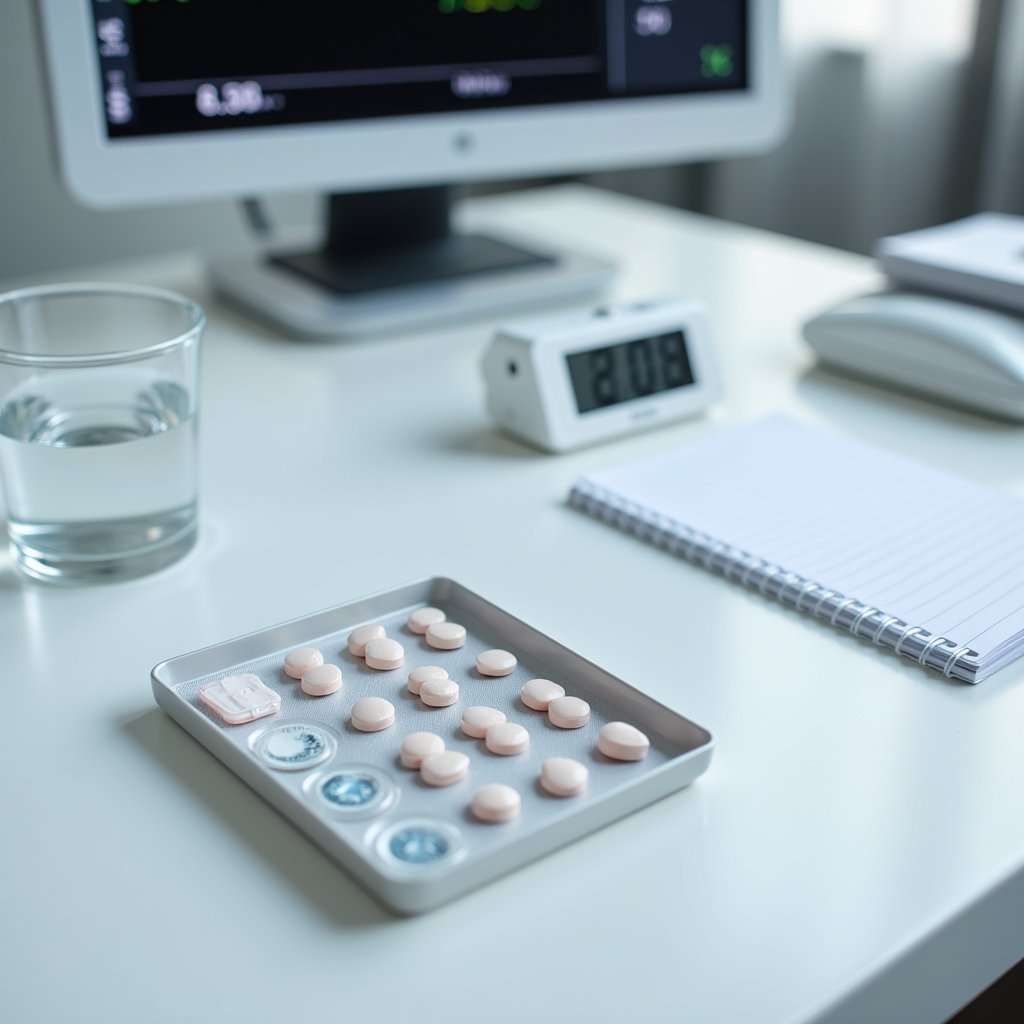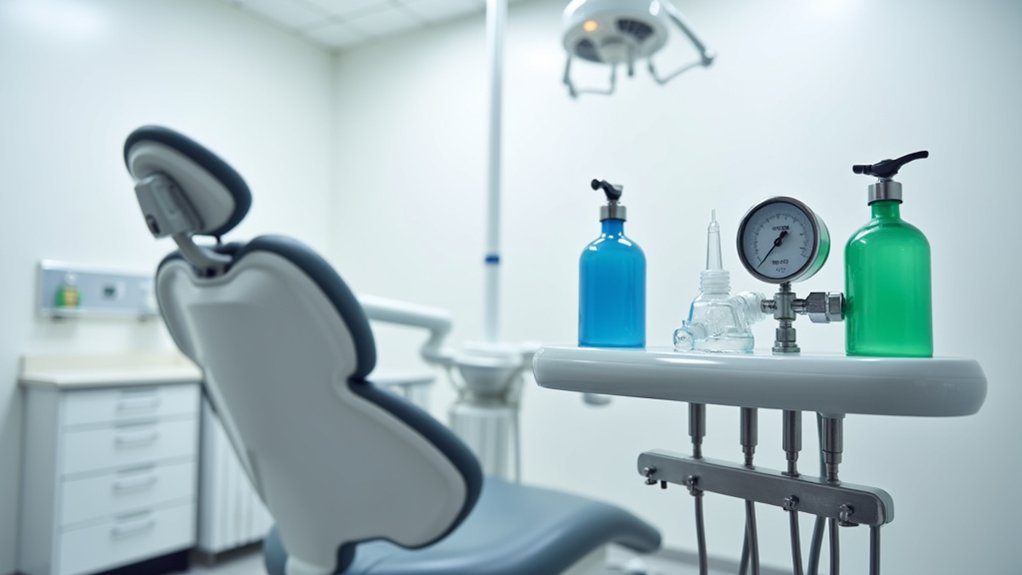Nitrous oxide’s effects will wear off quickly once you stop inhaling the gas, with most side effects clearing within 5-15 minutes. You’ll experience oxygen restoration immediately, and your cognitive function should return to normal within 30 minutes. Common after-effects like dizziness, disorientation, and nausea typically resolve within the first 10 minutes. While short-term recovery is rapid, understanding the factors that influence your individual recovery timeline can guarantee favorable safety and outcomes.
Immediate Physical Recovery Timeline

Three key phases characterize the immediate physical recovery from nitrous oxide exposure. The first phase occurs instantly when you stop inhaling the gas, as your body begins immediate oxygen restoration. Within minutes, your oxygen saturation levels normalize, and respiratory function returns to baseline. Short-acting sedation allows for this rapid recovery process.
The second phase unfolds over the next 5-10 minutes, during which you’ll experience full restoration of physical and cognitive capabilities. Your decision-making abilities, alertness, and coordination will return to normal as the gas leaves your system. This process mirrors the same recovery pattern seen in dental procedures where nitrous oxide is commonly used. Symptoms like headaches and dizziness may persist during this phase, particularly in cases of extended use.
The third phase marks the beginning of the complete detox process. While immediate physical effects dissipate rapidly, your body begins addressing any systemic impacts. During this phase, you’re no longer at risk for acute complications like hypoxia, though you may need monitoring for potential delayed effects.
Short-Term Side Effects Duration
Nitrous oxide’s short-term side effects wear off in distinct phases, with most symptoms clearing within 10-15 minutes post-administration. The absorption rate influences how quickly you’ll experience relief from common effects like nausea, dizziness, and fatigue. You’ll notice the most intense symptoms subsiding within the first 5 minutes after discontinuation. Most patients can safely drive home after the procedure since effects fade quickly. Patients typically return to normal cognitive function within 30 minutes of stopping treatment.
Dosage adjustments can affect recovery duration, with higher concentrations potentially extending the resolution time. You’ll typically experience sweating and shivering diminishing within minutes, while headaches and nausea may take up to 10 minutes to fully resolve. Receiving supplemental oxygen after treatment helps prevent lingering headaches. If you’re particularly sensitive or received prolonged exposure, fatigue might persist slightly longer. It’s critical to remain seated until you’ve completely recovered, especially if you’re experiencing any residual dizziness or disorientation.
Managing Common After-Effects

Managing after-effects of nitrous oxide requires a systematic approach to minimize discomfort and ascertain safe recovery. You’ll need to address multiple symptoms through targeted coping strategies while being mindful of potential medication interactions. The nasal mask is removed immediately after the procedure to begin the recovery process.
For dizziness and disorientation, breathe fresh air and avoid activities requiring balance until you’re fully alert. If you experience nausea, stay hydrated with clear fluids and consider approved anti-nausea medications. Some users may notice uncontrollable fits of laughter during the recovery period. Patients remain partially conscious throughout the procedure and can follow instructions from their provider.
To combat fatigue, schedule adequate rest time and don’t drive for at least an hour post-procedure. For headaches, verify proper gas mixture ratios and use approved pain relievers like ibuprofen. If you’re experiencing persistent issues or concerns about substance use, seek professional support through therapy, CBT, or outpatient programs. Most side effects typically resolve within 10-15 minutes with proper management.
Long-Term Recovery Considerations
Long-term recovery from nitrous oxide exposure requires thorough medical oversight and personalized treatment protocols. You’ll need ongoing neurological monitoring and lifelong supplementation needs that include regular B12 injections to prevent further complications.
| Recovery Component | Required Duration |
|---|---|
| B12 Injections | Lifelong monthly |
| Neurological Testing | 6-12 months minimum |
| Blood Monitoring | Every 3-6 months |
| Physical Therapy | As needed until stable |
| Mental Health Support | 12+ months |
Your recovery timeline depends on exposure duration and individual factors. You’ll undergo regular somatosensory testing to track nerve function improvement, while maintaining strict B12 supplementation protocols. Physical and occupational therapy may continue until you’ve reached ideal functional recovery. Long-term success requires adherence to treatment plans and complete abstinence from nitrous oxide to prevent permanent neurological damage.
Factors Affecting Recovery Speed

Your individual metabolic rate markedly influences how quickly your body processes and eliminates nitrous oxide, with factors like age, weight, and overall health playing pivotal roles.
Environmental conditions and physical activity levels can alter your recovery timeline, as increased body temperature and movement may expedite the elimination of residual N₂O from your system.
Prior substance use history impacts your body’s ability to metabolize nitrous oxide, particularly if you’ve experienced chronic exposure to other drugs that affect neurological function.
Individual Metabolic Rate Differences
Several interrelated biological factors determine how quickly your body processes and eliminates nitrous oxide, leading to substantial variations in recovery times between individuals.
Your unique metabolic profile considerably impacts nitrous oxide clearance through:
- Genetic variants like CYP2E1 and A118G polymorphisms that directly affect your liver’s enzyme activity and metabolism speed
- Your body composition, where obesity-related factors can prolong retention due to N₂O’s high fat solubility and reduced hepatic efficiency
- Your gut microbiota diversity, which influences N₂O reduction rates through specialized bacterial enzymes
- Your age-specific metabolic capabilities, with children typically processing N₂O faster than elderly individuals due to heightened liver function
The presence of reactive oxygen species in your system can significantly accelerate the breakdown of nitrous oxide. Individual differences in temperature recovery rates during nitrous oxide exposure have been shown to vary significantly between subjects. These individual differences explain why recovery times can range from 15 minutes to several hours, depending on your unique physiological profile. Early research by Humphry Davy in 1800 first documented these varying response times among different individuals during his systematic studies of the gas.
Environment and Physical Activity
Beyond individual metabolic factors, the environment where nitrous oxide exposure occurs and subsequent physical activity profoundly influence recovery speed. Your recovery time drastically varies between controlled medical settings versus unregulated recreational environments, with clinical exposures showing faster resolution of side effects through immediate oxygen therapy.
| Factor | Impact on Recovery |
|---|---|
| Clinical Setting | 2-22 minutes with oxygen therapy |
| Physical Activity | Accelerates metabolic clearance |
| Ambient Temperature | Affects circulation efficiency |
| Personal Hydration | Influences metabolic processing |
| Oxygen Levels | Enhances elimination rate |
You’ll experience faster recovery in oxygen-rich environments while maintaining physical activity. Controlled medical settings optimize these factors through regulated exposure duration and immediate oxygen supplementation. Your ambient temperature conditions can affect circulation efficiency, while personal hydration levels impact your body’s ability to process and eliminate the gas effectively.
Prior Drug Use Impact
Prior substance use patterns markedly influence the duration and severity of nitrous oxide side effects, with chronic exposure extending recovery times considerably. If you have preexisting psychiatric disorders or a history of compounding substance abuse, you’ll need to prepare for potentially longer recovery periods, as these conditions can complicate your healing process.
- Your chronic N₂O use (averaging 14.5 months) will greatly extend recovery time, potentially up to 1.5 years
- Your daily abuse patterns can trigger severe neurologic complications requiring months of intensive treatment
- Your existing B12 deficiency from prior substance use will worsen neuropathy symptoms
- Your delayed treatment seeking (beyond 6 months) may extend recovery to 72 weeks, especially with preexisting conditions
Early intervention with B12 therapy remains essential for ideal recovery outcomes, regardless of prior substance use history.
Warning Signs of Prolonged Effects
While most nitrous oxide side effects resolve quickly, certain warning signs indicate potentially dangerous prolonged effects that require immediate medical attention. If you’re experiencing persistent dizziness, confusion, or dissociation beyond 24 hours after exposure, these may be signs of hypoxia requiring urgent care. Watch for allergic reaction indicators like ongoing facial swelling, throat tightness, or skin rashes that don’t subside. Children and toddlers may experience nausea and headaches following exposure to nitrous oxide. Chronic exposure exceeding twenty parts per billion can lead to cumulative toxic effects in the body.
If you develop numbness, tremors, or coordination problems that persist, you should seek immediate medical help, as these could signal vitamin B12 deficiency or nerve damage. Other concerning symptoms include prolonged breathing difficulties, slurred speech, or unusual psychiatric symptoms like paranoia or hallucinations. Recreational users who mix nitrous oxide with other recreational drugs may experience more intense and dangerous side effects. These effects may indicate serious complications that won’t resolve without proper treatment.
Safe Usage and Recovery Guidelines
Safe and effective nitrous oxide administration requires strict adherence to established protocols and monitoring guidelines. You’ll need to follow specific room ventilation requirements and maintain continuous patient safety monitoring throughout the procedure. Practitioners must ensure the delivery system flow meter remains clearly visible and well-maintained to guarantee accurate gas administration.
Never exceed 30-minute exposure limits per session, with a maximum of two sessions within 24 hours. Guarantee proper scavenging systems and ventilation controls are active before administration. Observe your critical signs continuously, including oxygen saturation and blood pressure.
Receive 100% oxygen for 2-5 minutes after procedure completion. You must have a responsible adult accompany you home after treatment. Your provider will evaluate your recovery using strict discharge criteria, including full orientation and stable ambulation. Don’t drive or perform complex tasks until you’ve fully recovered from the sedation effects.
Frequently Asked Questions
Can Nitrous Oxide Side Effects Be Reversed With Specific Medications or Treatments?
There’s no specific antidote to reverse nitrous oxide side effects, but healthcare providers can manage symptoms through supportive treatments. You’ll receive oxygen therapy to help clear the gas from your system more quickly.
If you experience severe reactions, IV fluid administration may help stabilize your condition. Most side effects naturally resolve within minutes once you stop receiving the gas, making additional medications usually unnecessary.
How Does Age Impact the Recovery Time From Nitrous Oxide Exposure?
Your age-related metabolism can influence how quickly you recover from nitrous oxide exposure. While age-dependent clearance rates aren’t extensively documented, there are some general patterns: you’ll typically recover within 5-15 minutes regardless of age, though older adults may experience slightly prolonged effects due to slower metabolic rates.
If you’re elderly, you might need adjusted dosing in clinical settings. Long-term B12-related complications can affect any age group with chronic exposure.
Are There Genetic Factors That Make Some People More Sensitive?
Yes, genetic factors can considerably influence your sensitivity to nitrous oxide. Your individual metabolism, particularly genes affecting B12 processing and neurological function, plays an essential role.
If you have a genetic predisposition to B12 deficiency or certain metabolic disorders, you’ll likely experience more intense reactions. Additionally, genetic variations in your liver enzymes can affect how quickly you process the substance, potentially increasing your vulnerability to its effects.
Can Vitamin Supplements Help Speed up Recovery From Side Effects?
Vitamin B12 supplementation is the primary nutritional support that can help your recovery from nitrous oxide side effects. You’ll need a specific supplementation regimen, typically involving high-dose B12 supplements or injections, as nitrous oxide directly disrupts B12 metabolism.
While other vitamins won’t markedly accelerate recovery, B12 supplementation is indispensable for preventing and reversing neurological complications. Early intervention with B12 produces the most effective results.
Does Previous Nitrous Oxide Exposure Change How Long Side Effects Last?
Your previous recreational use can markedly alter how you experience nitrous oxide effects. If you’ve developed tolerance through frequent exposure, you’ll likely notice diminished acute effects, though this doesn’t necessarily shorten their duration.
The dosage amount remains the primary factor in side effect intensity. However, considerably exposure can lead to cumulative damage, potentially extending recovery times and making you more susceptible to long-term complications like B12 deficiency.






